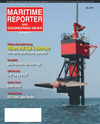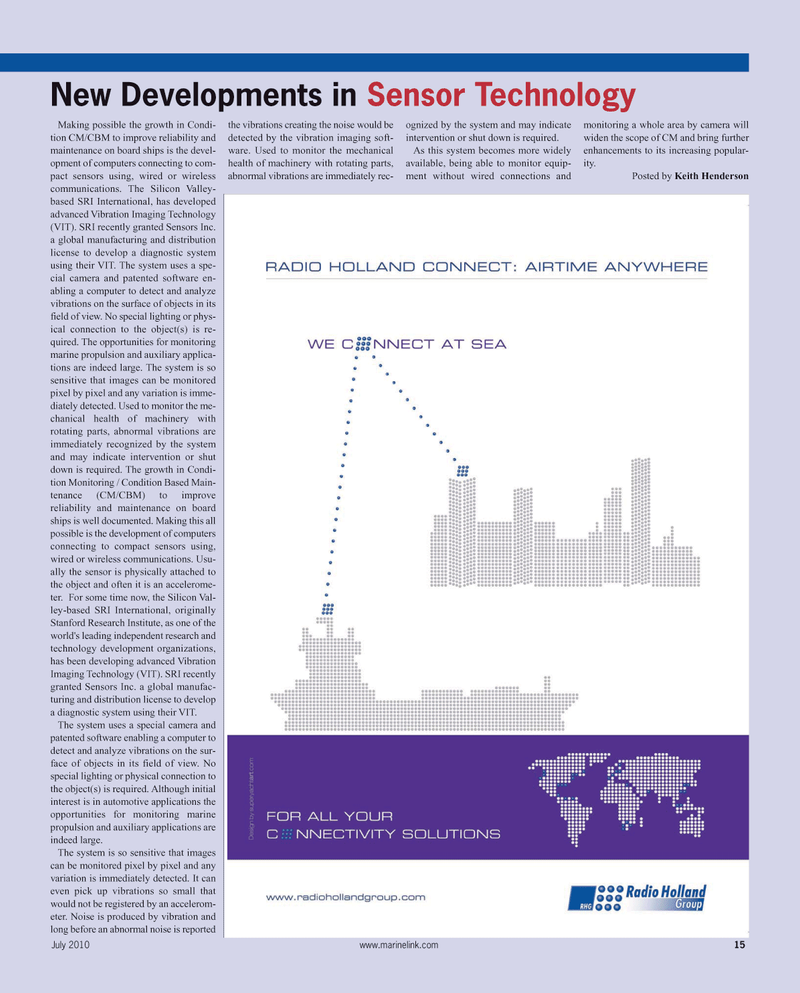
Page 15: of Maritime Reporter Magazine (July 2010)
Satellite Communication Edition
Read this page in Pdf, Flash or Html5 edition of July 2010 Maritime Reporter Magazine
July 2010 www.marinelink.com 15
Making possible the growth in Condi- tion CM/CBM to improve reliability and maintenance on board ships is the devel- opment of computers connecting to com- pact sensors using, wired or wireless communications. The Silicon Valley- based SRI International, has developed advanced Vibration Imaging Technology (VIT). SRI recently granted Sensors Inc. a global manufacturing and distribution license to develop a diagnostic system using their VIT. The system uses a spe- cial camera and patented software en- abling a computer to detect and analyze vibrations on the surface of objects in its field of view. No special lighting or phys- ical connection to the object(s) is re- quired. The opportunities for monitoring marine propulsion and auxiliary applica- tions are indeed large. The system is so sensitive that images can be monitored pixel by pixel and any variation is imme- diately detected. Used to monitor the me- chanical health of machinery with rotating parts, abnormal vibrations are immediately recognized by the system and may indicate intervention or shut down is required. The growth in Condi- tion Monitoring / Condition Based Main- tenance (CM/CBM) to improve reliability and maintenance on board ships is well documented. Making this all possible is the development of computers connecting to compact sensors using, wired or wireless communications. Usu- ally the sensor is physically attached to the object and often it is an accelerome- ter. For some time now, the Silicon Val- ley-based SRI International, originally
Stanford Research Institute, as one of the world's leading independent research and technology development organizations, has been developing advanced Vibration
Imaging Technology (VIT). SRI recently granted Sensors Inc. a global manufac- turing and distribution license to develop a diagnostic system using their VIT.
The system uses a special camera and patented software enabling a computer to detect and analyze vibrations on the sur- face of objects in its field of view. No special lighting or physical connection to the object(s) is required. Although initial interest is in automotive applications the opportunities for monitoring marine propulsion and auxiliary applications are indeed large.
The system is so sensitive that images can be monitored pixel by pixel and any variation is immediately detected. It can even pick up vibrations so small that would not be registered by an accelerom- eter. Noise is produced by vibration and long before an abnormal noise is reported the vibrations creating the noise would be detected by the vibration imaging soft- ware. Used to monitor the mechanical health of machinery with rotating parts, abnormal vibrations are immediately rec- ognized by the system and may indicate intervention or shut down is required.
As this system becomes more widely available, being able to monitor equip- ment without wired connections and monitoring a whole area by camera will widen the scope of CM and bring further enhancements to its increasing popular- ity.
Posted by Keith Henderson
New Developments in Sensor Technology

 14
14

 16
16
